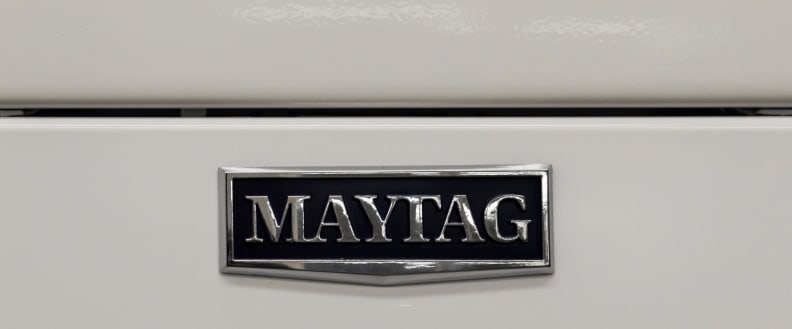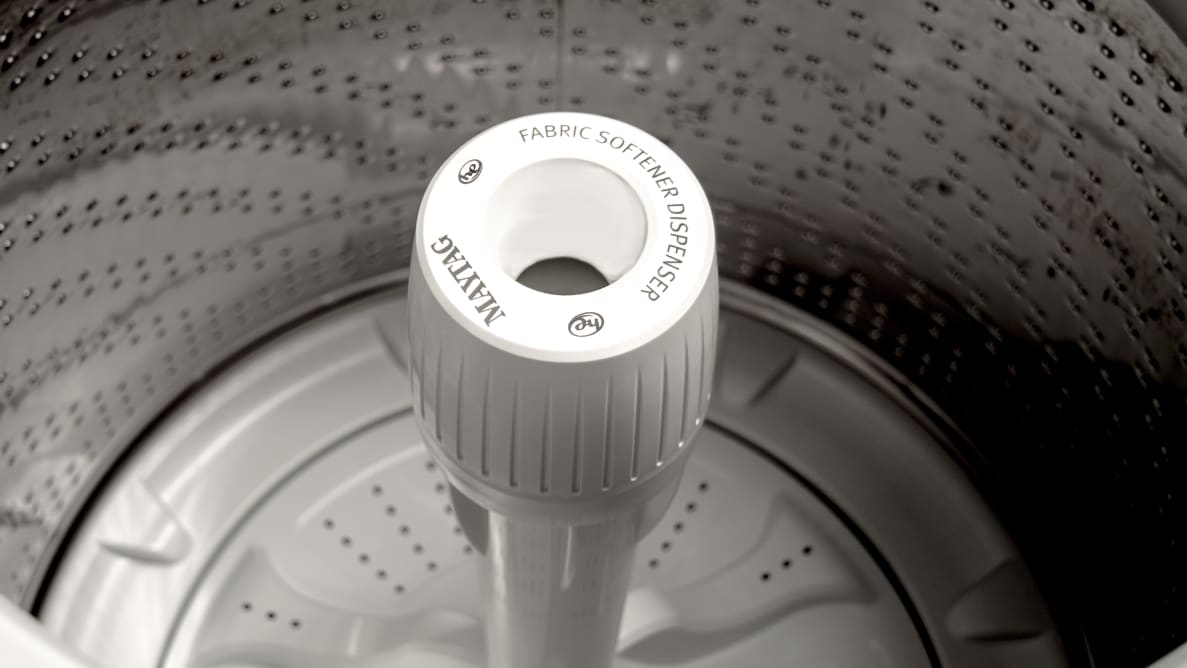Pros
Cons
{{brightcove '4365798674001'}}
To read our full review of this washer's matching dryer, the Maytag MEDC415EW click here.
Design & Usability
You've seen this before
{{ photo_gallery name="Maytag" }}
Look up "washing machine" in an old dictionary and you might see a picture of an appliance that looks just like the Maytag MVWC415EW. The pole agitator is a blast from the past: Sure, it beats stains out of laundry, but also takes up a lot real estate in the already cramped drum.
The control panel also uses rather retro design language. Instead of buttons, the MVWC415EW's panel is all dials. Soil Level and Water Temperature settings are located on the left, and the more situational Extra Rinse and Pre Soak options are on the far right. And if you just want to pick a cycle from the main dial and hit "start," that's fine too.
The older style lid means no soft-close hinges, so watch your fingers. This washer also requires users to add detergent directly to the drum, rather than a dispenser that would automatically distribute it through the water.
Performance & Features
A design that ventures nothing, gains nothing

This is your mother's washer.
There's a reason why pole agitator washers have stayed around for so long–consumers swear by them. The MVWC415EW doesn't reinvent the wheel, but it uses what's worked over the last five decades to good effect.
PowerWash impressed us the most, as it should have. Maytag's advertising claims PowerWash offers the best stain removal in its class, and our tests proved it can remove stains with the best cycles out there. Using 21 gallons of water but taking an hour and 20 minutes, this cycle removed stains better than ones found on machines twice the price.
If you're in a hurry, the Normal cycle is a faster choice. We clocked this cycle in at 50 minutes, half an hour shorter than PowerWash. But in the absence of other options, the Normal cycle is going to serve as your Quick Wash as well. Even though it was quicker, Normal used just as much water as PowerWash. In fact, when we reviewed all the data from this washer, a pattern of high water usage began to emerge.
We estimate that the MVWC415EW will draw $70 in utility costs out of your pocket per year, about double what the average front loader would. It might not sound like much, but if the machine lasts 10 years, that's $700 in utility costs—even more than MSRP!
You also need to consider clothing wear and tear when thinking long term. Although a pole agitator might be good at removing stains, it's harsh on laundry. We observed instances of loose threads catching on the agitator, and all that mechanical action prematurely wore down fabric surfaces.
For in-depth performance information, please visit the Science Page.
Warranty
The Maytag Centennial MVWC415EW has a three-year warranty from the date of purchase, covering parts and labor. After that, there's a ten-year warranty on the drum and drive motor covering only parts, no labor.
Before You Buy
A solid entry-level washer
Although the MVWC415EW uses technology from a generation ago, it works well enough. This washer's stain removal is more than adequate considering the low sale price of around $500. However, the MVWC415EW's long term value is less defensible. High water usage over the lifetime of the machine could cost you $700 over a decade, and pole agitators tend to damage clothing.
If you plan on PowerWashing sturdy clothes constantly, those up-front savings are fine. But if you wash a variety of clothes that you plan on keeping, even the low sale price makes less sense. We recommend following those care guide tags on your laundry. If you do, the Maytag Centennial MVWC415EW will treat you right.
By the Numbers
The Maytag Centennial MVWC415EW borrows design from a bygone era, but that doesn't mean it can't get the job done. To see if this old technology holds up to modern standards, we brought the Centennial into our appliance labs.
Cleaning Performance
We test stain removal with mechanically coated stain strips. Each strip is coated with substances like blood, red wine, and cocoa powder. We place each strip into test loads made up of towels, bedsheets, and pillowcases. After washing each load in selected cycles, we analyze the strips with a photospectrometer. A computer determines how clean the strip is by quantifying each stain's color.

Before and after test stain results using the Normal cycle. From left to right: control, sweat, dirt, blood, cocoa, and red wine.
Overall, the MVWC415EW had a good showing, especially during the PowerWash cycle. After an hour and 20 minutes, it showed a weakness only to oil stains–which are difficult for most washers. The Normal cycle on the hottest setting with an extra rinse was the runner up, lagging 4% behind PowerWash. The extra hot water gave this cycle an edge against oil, but fared weaker against blood and red wine. The Normal cycle on medium heat and no extra rinse came in third. It removed 8% fewer stains than PowerWash, but what was lost was gained in time–the Normal cycle required only 50 minutes to complete.
Most cycles did best against protein-based stains like cocoa and blood. This is a sign of good temperature profiles, meaning hot water isn't added too early, which "bakes" stains into cloth.
Efficiency
When we consider a washer's efficiency, we take into account its resource usage and spin. We hooked up the MVWC415EW to water and electricity meters to determine how much each cycle costs based on national averages. When we took that data and multiplied it out to a year's worth of laundry, it came out to about $70. Over the 10-year expected lifetime of the machine, that could run you up to $700.
What comes out of a washer is equally important. The more wet laundry is coming out of a washer, the more time and energy your dryer will have to expend. On average, the MVWC415EW spun out about 46% of excess water, which gives it a middling score in our book. We like to see numbers closer to 50%.
Clothing Wear & Tear
Washers are supposed to clean your clothes, not destroy them. We use mechanical action strips to quantify how much damage each cycle inflicts on laundry. These strips fray according to the turbulence of a wash cycle, and once a cycle is complete, we take the strips out and count the number of loose threads that can be pulled away more than one centimeter.
With its big pole agitator, we found the MVWC415EW was not friendly to more delicate pieces of clothing. On average, we counted 56 loose threads, meaning delicate cottons will wear out prematurely. The PowerWash cycle was the worst offender, averaging 84 loose threads per load.
Meet the tester
Jonathan Chan currently serves as the Lab Manager at Reviewed. If you clean with it, it's likely that Jon oversees its testing. Since joining the Reviewed in 2012, Jon has helped launch the company's efforts in reviewing laptops, vacuums, and outdoor gear. He thinks he's a pretty big deal. In the pursuit of data, he's plunged his hands into freezing cold water, consented to be literally dragged through the mud, and watched paint dry. Jon demands you have a nice day.
Checking our work.
Our team is here to help you buy the best stuff and love what you own. Our writers, editors, and experts obsess over the products we cover to make sure you're confident and satisfied. Have a different opinion about something we recommend? Email us and we'll compare notes.
Shoot us an email

